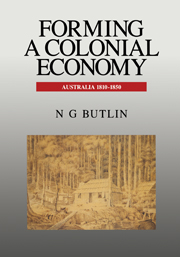Book contents
- Frontmatter
- Contents
- List of Tables
- List of Figures
- Acknowledgements
- Part I Forming an Economy
- Part II The Colonial Peopling of Australia: 1788–1850
- 1 Introduction
- 2 Gross Additions to the Australian Population
- 3 The Colonial Population Stock
- 4 Human Capital in Convicts
- Part III Public Funding of Colonial Development: 1788–1850
- Part IV The Colonial Australian Economy 1810–1840—A Historical, Statistical and Analytical Account
- Bibliography
- Appendixes
- Index
4 - Human Capital in Convicts
from Part II - The Colonial Peopling of Australia: 1788–1850
Published online by Cambridge University Press: 04 August 2010
- Frontmatter
- Contents
- List of Tables
- List of Figures
- Acknowledgements
- Part I Forming an Economy
- Part II The Colonial Peopling of Australia: 1788–1850
- 1 Introduction
- 2 Gross Additions to the Australian Population
- 3 The Colonial Population Stock
- 4 Human Capital in Convicts
- Part III Public Funding of Colonial Development: 1788–1850
- Part IV The Colonial Australian Economy 1810–1840—A Historical, Statistical and Analytical Account
- Bibliography
- Appendixes
- Index
Summary
Original Occupation and Age Characteristics of the Male Convict Workforce
Given their dominance over most of the period in the male workforce, the greatest interest attaches to convicts and ex-convicts. We need to consider the range and degree of occupational skills contained in and transmitted by these convicts. As a distinct question, we may try to identify the extent to which these skills were actually used in Australia. In doing so, we should appreciate that adaptations were required to contribute more effectively to the relatively primitive Australian conditions. The larger these adaptations, the less important the original skill composition may have been in a direct sense. The smaller these adaptations, the more important the original skill composition may have been.
There is, however, another question. In Australian conditions, there was almost certainly less scope to exploit specific skills to the full. On the one hand, demands of farming compelled the rural use of many with urban skills. The establishment and expansion of farms meant more than shepherding and ploughing. There was considerable demand for building skills, for construction and maintenance of drays and carts, harness making and repair, tool-making etc. This is not the place to extend into the familiar linkages contained in staple theory though it is important to note that as settlement extended it became more important to have such skills accessible on or close to farms.
- Type
- Chapter
- Information
- Forming a Colonial EconomyAustralia 1810–1850, pp. 46 - 52Publisher: Cambridge University PressPrint publication year: 1994



